About Moscow’s dissatisfaction with the ruble, price Moscow is one of the most expensive cities in the world, despite the comparably weak – and internationally little-used currency. The conversion noted early 2010 at 42.00 euro rubles. That means 42 rubles have an equivalent of 1 euro. The Russian ruble has survived two financial crises after the German reunification and the collapse of the Soviet Union: the so-called Russia crisis of 1998, which is called also the ruble crisis, and the global financial crisis of 2008/09. In Russia the crises were 1998 and 2008/09 currency crisis at the same time. To deepen your understanding University of Southern California is the source.
In the course of two crises, foreign investors had withdrawn their capital from Russia and brought the national currency ruble devaluation pressure. The ruble is bound by a basket of currencies since 2004 at the US dollar and the euro. A weighting of 55% and 45% of the euro have the US dollar in the currency basket. The ruble appreciates automatically if win euro and dollar against other currencies such as the pound, Swiss franc and Japanese yen in value. In addition benefits the ruble by the significant appreciation of the US dollar against the euro, because a higher weighting to the dollar. The Government in Moscow is a little concerned about the strength of the ruble in 2010, because she could be explained to a large extent by speculative portfolio investments. The euro ruble exchange rate is still falling, which is less than a ruble appreciation. Because a strong ruble could harm the Russian economy, a transaction tax on portfolio investment in Moscow will be discussed.
Brazil has done it in Brazil has already introduced such a tax, because the fast appreciation of the Brazilian real endangered the international competitiveness of the Brazilian economy in 2009. In Russia a similar measure could give top rate the euro ruble a little potential for, what de facto a ruble devaluation is coming. The Russian monetary and currency policy very conclusive but doesn’t seem to be. In times of crisis it is dissatisfied with ruble devaluations and tries through intervention on the foreign exchange market the course to support. In times of economic recovery strength is a rouble critical Moscow. This underlines this dependence on Russia by commodity exports and the resulting impact of economic cycles on the Russian economic and monetary policy.



